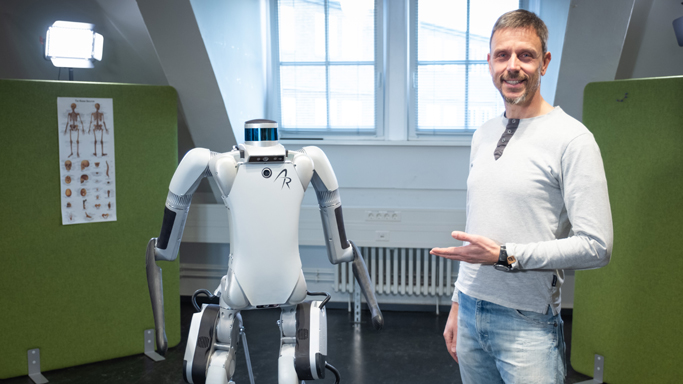
Brain City Berlin Ambassador: Prof. Dr.-Ing. Ivo Boblan (Berlin University of Applied Sciences and Technology)
Department of Electronics – Mechatronics – Optometry
Intelligent robots will significantly alter people's lives and working habits over the next few years. In addition to high-performance industrial robots, humanoid robots will play a major role in everyday life. Against the backdrop of demographic change, they will take on simple and complex tasks in medicine and nursing.
These robots have to learn to understand their human counterparts and feel like a human in order to be accepted by people as a ‘social partner’. Ivo Boblan from Berlin University of Applied Sciences and Technology is investigating this development, One question undercuts his work: To what extent should a robot be ‘human’?
Professor Boblan, how would you explain your work to a layperson? What are you currently researching?
My team and I are working on what is known as soft robotics. This involves producing robots that are as compliant, soft and flexible as possible during interaction with humans, i.e. as we expect when interacting with other people.
This is different to robots as we know them today. Why do you think these particular robot characteristics are so important?
We are convinced that these soft, flexible characteristics will not only make human-machine interaction easier, but will increase the acceptance of robots within the wider community. Apart from artificial intelligence, this ‘human’ component will be the decisive factor in accepting robots as ‘social’ partners in the future.
Why do we need robots in day-to-day life in the first place?
The population is ageing, while there are fewer and fewer junior staff members. As part of demographic change, we need to focus on relieving the burden on older employees in everyday life and at work. They should be exempt from heavy work, and activities in the workplace should be more ergonomic, so that these people do not encounter health problems as they become older and continue to gain satisfaction from their work. At the same time, older people need an increasing amount of assistance and care. We need to provide them with help and support to remain independent as much as possible. Robots can make a decisive contribution here.
Could you give us any specific examples in day-to-day life?
We are currently focusing on three specific applications. In industrial assembly operations, robots should remove the physical burden on assembly workers and take on heavy work such as lifting, pulling or pushing heavy loads. In medicine and nursing, they can take on simple and complex tasks, such as providing mechanical support to caregivers when rehabilitating patients – often a strenuous task. In the long term, care assistance systems of this kind should be available to patients at home at affordable prices. In the home environment, we are also seeing a third major application. Robots can, for example, assist people with dementia or paraplegics with day-to-day chores.
This all sounds highly application-oriented. Is that why you joined Berlin University of Applied Sciences?
Yes, that’s right. Robotics is a traditional application science. We have to construct our robots and test them under realistic conditions. In particular, we have to find out how people interact with them, which isn’t something we can simulate in a laboratory. This is why vocational universities are the ideal places for this. They provide the best conditions for application-focused research and development.
However, robotics is not only an application-focused science; it is also interdisciplinary. Are you benefiting from your proximity to other scientific institutions in Berlin?
We take a multifaceted approach to our work, and collaborate closely with other disciplines. There are, for example, technology sociologists who tell us how robots are viewed and perceived by society. Interaction designers help us make interaction between humans and machines more enjoyable, while behavioural biologists show us how humans interact with each other on a very subtle level. These are all aspects that robots have to learn in order to understand their human counterparts. The high density of universities in Berlin provides us with direct access to all these disciplines. That’s a fantastic situation to be in, and it helps us tremendously.
Would you say, then, that Berlin is the ideal research location for you?
Yes, I’d say so, but this is not the only reason. In many ways, Berlin is the ideal city for our research work. As a young city, it’s in a constant state of flux. Plenty of new concepts are being created, and structures have not yet been fully introduced. Berlin thinks outside the box. The people here are open to new ideas and are prepared to experiment. These are the best conditions for our research. It allows us to spread the word about our robots and mobilise and motivate people into helping with developments.
What would you say about Berlin in a personal capacity?
I was born and bred in Berlin. I love the city. It is growing at a rapid pace and is unconventional and trendy. And although the city is changing at lightning speed, there are still hidden corners and places where you can discover something new. I enjoy being here and right now, I simply can’t imagine ever leaving Berlin. I personally see Berlin as one of the world’s most future-oriented metropolises. It’s exciting not only to be here, but to contribute at the same time.